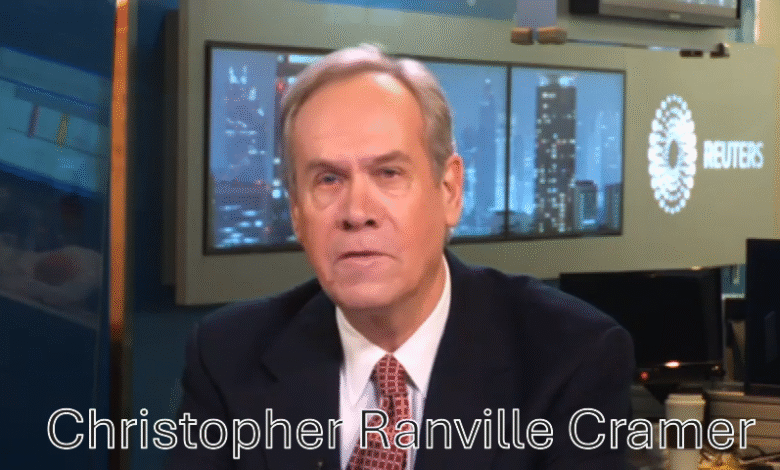Chris Cramer: The Fearless Voice Behind Journalist Safety and Global News Leadership
How One British Broadcaster Revolutionized International Reporting and Protected Generations of War Correspondents

Introduction
Chris Cramer was a pioneering figure in international journalism, best known for his fearless leadership at the BBC and CNN International, as well as his lifelong advocacy for journalist safety. Born in Portsmouth, England, Cramer began his career as a teenage reporter and rose to become one of the most influential media executives of his time. His firsthand experience as a hostage during the 1980 Iranian Embassy siege deeply impacted his mission to protect journalists in conflict zones.
Over the course of his career, Cramer introduced groundbreaking reforms in hostile-environment training, established global safety standards, and led newsrooms through major world events and the digital revolution. From mentoring top correspondents to founding the International News Safety Institute, his contributions continue to shape modern journalism.
Quick Bio
| Full Name | Christopher Ranville Cramer |
|---|---|
| Date of Birth | January 3, 1948 |
| Place of Birth | Portsmouth, Hampshire, England |
| Nationality | British |
| Occupation | Journalist, News Executive |
| Known For | BBC, CNN International, Journalist Safety Advocacy |
| Spouse | Helen Sarkies (ex), Nina Human |
| Children | Hannah, Richard, Nicolette |
| Died | January 16, 2021 (aged 73) |
Chris Ranville Cramer: The Fearless Voice Behind Journalist Safety and Global News Leadership was born on January 3, 1948, in Portsmouth, England. His upbringing was marked by strict discipline, especially under the guidance of his father, a police officer. This environment forged the resilience that would define his journalistic career. He left school at the age of 17, determined to carve out a path in the media world without formal university training.
His first job was as a reporter for The Portsmouth Evening News. Even at that early stage, Cramer displayed a talent for storytelling and a keen sense of justice—traits that would eventually define his contributions to international journalism.
Start of Career and Rise at the BBC
Cramer began working with BBC Radio Solent in 1970, transitioning later into BBC television. His sharp eye for global news and dedication to accuracy quickly earned him promotions within the newsroom. Over time, he became Head of Newsgathering at the BBC, where he led some of the broadcaster’s most iconic coverage.
Major events under his watch included the Ethiopian famine, the Tiananmen Square protests, and the fall of the Berlin Wall. More importantly, Cramer began developing systems to protect BBC journalists in war zones—a mission that would define the rest of his career.
The Iranian Embassy Siege and Its Impact
One of the most pivotal moments in Chris Cramer’s life occurred in 1980. While collecting a visa at the Iranian Embassy in London, he was taken hostage during a siege. After feigning illness, he was released early and provided critical intelligence to the British authorities preparing the SAS rescue operation.
This harrowing experience profoundly shaped his views on journalist safety. Cramer developed post-traumatic stress disorder (PTSD), a condition he later openly discussed to highlight the psychological toll of field reporting.
Championing Journalist Safety Around the Globe
Following his hostage experience, Cramer initiated a groundbreaking overhaul of safety standards for journalists. Under his leadership, the BBC implemented hostile-environment training, pre-deployment risk assessments, and emergency trauma support systems. These measures became the gold standard in the industry.
In 2003, he co-founded the International News Safety Institute (INSI), serving as its first president until 2012. Through this platform, he promoted global awareness about the risks journalists face in conflict zones and advocated for their mental health needs.
Leading CNN International Through a New Era
In 1996, Chris Cramer made a major move to the United States to head CNN International. Over the next 11 years, he transformed the network’s approach to global news. He steered CNN through the digital age, emphasizing real-time reporting, mobile journalism, and video storytelling.
Cramer also played a pivotal role in shaping CNN’s response to the events of 9/11. He established the position of Senior Editor for Middle East Affairs, further reinforcing his commitment to informed, on-the-ground journalism.
Career After CNN and Multimedia Innovation
After stepping down from CNN in 2007, Cramer joined Reuters as Global Editor of Multimedia and Editor-at-Large. At Reuters, he led efforts to modernize storytelling by integrating multimedia formats and video-first strategies. Later, he took a leading role in The Wall Street Journal’s video division, overseeing content innovation during the rise of digital platforms.
In every role, Cramer left behind a legacy of integrity, courage, and technological foresight that continues to influence the industry today.
Personal Life and Relationships
Chris Cramer married Helen Sarkies in 1982, and they had a daughter named Hannah. After their divorce in the early 1990s, he moved to the United States, where he married Nina Human in 2003. The couple had two children together: Richard and Nicolette.
Despite his high-pressure career, Cramer remained deeply committed to his family. Friends and colleagues often spoke of his dark wit, strong values, and protective instincts—both at home and in the newsroom.
Legacy of Courage and Ethical Journalism
Chris Cramer’s impact on journalism goes far beyond the newsrooms he led. He is credited with revolutionizing journalist safety protocols, mentoring generations of reporters, and elevating ethical standards in the global media landscape.
His name is frequently mentioned alongside the likes of Jeremy Bowen and Richard Sambrook—journalists whose careers he helped launch. Cramer didn’t just manage teams; he empowered them to pursue the truth while staying safe and supported.
Final Years and Death
Chris Cramer passed away from cancer on January 16, 2021, at the age of 73. His death was widely mourned across the journalism world. Publications like The Guardian, Reuters, and BBC News honored his achievements and his unmatched influence on newsroom safety and global reporting.
Even in his final years, Cramer remained a voice of wisdom and principle, never hesitating to challenge media institutions to do better for their journalists.
Conclusion
Chris Cramer’s legacy is one of courage, integrity, and innovation. His commitment to both the truth and the well-being of journalists transformed newsrooms around the world. Through his roles at the BBC, CNN, Reuters, and the INSI, he ensured that journalist safety became a global priority, not an afterthought.
Even after his passing in 2021, Cramer’s influence lives on through the standards he helped create and the people he mentored. His story is a reminder that journalism is not only about reporting the news—but also about protecting those who bring it to light.
Frequently Asked Questions (FAQ)
Who was Chris Cramer?
Chris Cramer was a British journalist and media executive known for his leadership roles at BBC, CNN International, and Reuters. He was a pioneer in journalist safety and digital innovation in news.
What was his most notable contribution to journalism?
Cramer is widely credited with introducing hostile-environment training for reporters and co-founding the International News Safety Institute (INSI).
What incident shaped his views on journalist safety?
He was taken hostage during the Iranian Embassy siege in London in 1980, which gave him firsthand experience of the dangers journalists face.
Did he have a family?
Yes, he was married twice and had three children: Hannah, Richard, and Nicolette.
How is he remembered today?
Chris Cramer is remembered as a fearless newsroom leader, a tireless advocate for journalist safety, and a mentor to some of the industry’s most respected voices.



